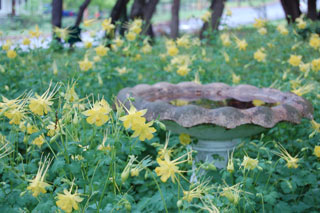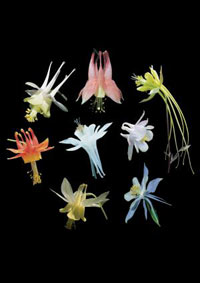Human Flower Project
Friday, June 08, 2007
Going to Any Lengths: Columbine
Plants and pollinators haven’t been sharing the workload, of evolution, anyway.

Hinckley’s columbine (Aquilegia Hinckleyana)
making adjustments for survival’s sake
Photo: Human Flower Project
Any couple that hopes to split things—childcare, housework, bread-winning, bread-baking—right down the middle has our good wishes. But we’ve never seen it quite work out in equal fractions. Same goes, it appears, for the chore of evolution.
A new study published in the latest issue of Nature bears evidence that flowering plants and their pollinators, previously thought to be paragons of equality, are like the rest of us. Plants are stretching, curling, bending over backward to make things work.
Charles Darwin noted that the strange shapes of some flowers were perfectly receptive to the nectar-gathering equipment of some equally strange birds and insects that pollinated them. He proposed that plants and their pollinators were in an evolutionary “race,” each upping the ante in accessibility. Over time both species, according to Darwin, would be at an evolutionary advantage (and mutually hung up, too). This seems to have been the prevailing view of co-evolution.
 Assorted columbines, genus Aquilegia
Assorted columbines, genus Aquilegia
(they try harder)
Photo: SA Hodges, MA Hodges, D Inouye
via Science Daily
But researchers Justen Whittall and Scott Hodges have found evidence that plants are actually playing evolutionary catch up, as the pollinators in their locality change. “Whittall and Hodges found that evolution acts in a more one-sided fashion in many plants: the plants evolve nectar spurs to match the tongue-lengths of the pollinators. Then the process stops, and only starts again when there is a change in pollinators.” Call it “the trailing spouse.”
The biologists focused their attention on columbines, and found that these tubular flowers (or spurs) lengthened in stages, as pollinating bees were replaced by hummingbirds and hawkmoths, with longer nectar-sipping (and pollinating) apparatuses.
We’ve posted earlier pieces about symbiotic couples: the
“ title=” sunbird”>sunbird-dependent Babiana ringens and bat-pollinated chiropterophilous. But this new research strikes us as eminently believable. Columbines and their pollinators may not be equals in the work of evolution but they’re the equals of most other couples.




